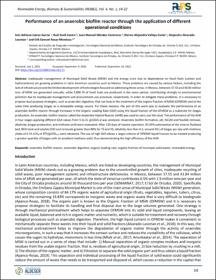Mostrar el registro sencillo del ítem
Performance of an anaerobic biofilm reactor through the application of different operational conditions
| dc.contributor.author | Juárez-García, Inés Adriana | |
| dc.contributor.author | Snell-Castro, Raúl | |
| dc.contributor.author | Méndez-Contreras, Juan Manuel | |
| dc.contributor.author | Vallejo-Cantú, Norma Alejandra | |
| dc.contributor.author | Alvarado-Lassman, Alejandro | |
| dc.contributor.author | Rosas-Mendoza, Erik Samuel | |
| dc.date.accessioned | 2023-01-11T04:11:45Z | |
| dc.date.available | 2023-01-11T04:11:45Z | |
| dc.date.issued | 2022-09-18 | |
| dc.identifier.other | https://doi.org/10.56845/rebs.v4i1.71 | |
| dc.identifier.uri | http://repositorios.orizaba.tecnm.mx:8080/xmlui/handle/123456789/722 | |
| dc.description.abstract | Inadequate management of Municipal Solid Waste (MSW) and the energy crisis due to dependence on fossil fuels (carbon and hydrocarbons) are growing problems in Latin American countries such as Mexico. These problems are caused by various factors, including the lack of infrastructure and the limited development of technologies focused on addressing these areas. In Mexico, between 37.55 and 43.84 million tons of MSW are generated annually, while 5,896 PJ of fossil fuels are produced in the same period, contributing strongly to environmental pollution due to inadequate management and procurement-use processes respectively. In order to mitigate these problems, it is necessary to propose dual-purpose strategies, such as anaerobic digestion, that can help in the treatment of the organic fraction of MSW (OFMSW) and at the same time producing biogas as a renewable energy source. For these reasons, the aim of this work was to evaluate the performance of an anaerobic biofilm reactor through increases in the Organic Loading Rate (OLR) using the liquid fraction of the OFMSW as a substrate for biogas production. An anaerobic biofilm reactor called the Anaerobic Hybrid Reactor (AHR) was used to carry out this stud. The performance of the AHR in four stages applying different OLR values from 5 to 21 gCOD/L.d was analyzed. Anaerobic biofilm formation, pH, %COD and %solids removal, alkalinity, biogas production, and methane yield were evaluated. After 119 days of reactor operation, 93.45% colonization of the inverse fluidized bed, 85% total and soluble COD and removals greater than 80% for TS and VS, alkalinity less than 0.3, around 20 L of biogas per day with methane yields of 0.31 LCH4 at STP/gCODrem were obtained. The use of high OLR allows a larger volume of OFMSW liquid fraction to be treated producing a greater quantity of biogas with an excellent methane yield, thus demonstrating the high efficiency of the AHR. | es |
| dc.language.iso | en | es |
| dc.publisher | Asociación Latinoamericana de Desarrollo Sustentable y Energías Renovables A. C. | es |
| dc.relation.ispartofseries | 4;1 | |
| dc.subject | anaerobic biofilm reactor | es |
| dc.subject | anaerobic digestion | es |
| dc.subject | organic loading rate | es |
| dc.subject | organic fraction of municipal solid waste | es |
| dc.subject | renewable energy | es |
| dc.title | Performance of an anaerobic biofilm reactor through the application of different operational conditions | es |
| dc.type | Article | es |
Ficheros en el ítem
Este ítem aparece en la(s) siguiente(s) colección(ones)
-
Artículos (DCI) [72]



